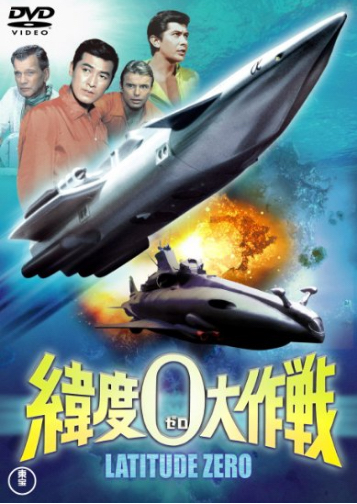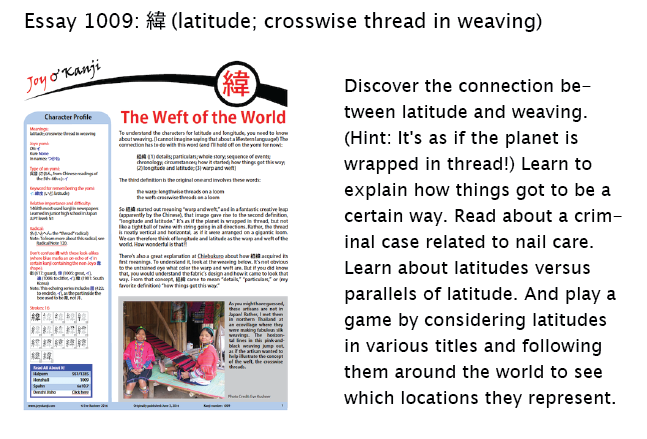Giving Latitude
When I embarked on essay 1009 on 緯 (latitude; crosswise threads in weaving), I didn't expect to find that Japanese speakers and English speakers took different approaches to the matters of latitude and longitude. Of course I was wrong!
To understand the characters for latitude and longitude, you need to know about weaving. (I cannot imagine saying that about a Western language!) The connection has to do with this word, which the Japanese read in several ways but primarily as けいい:
経緯 (けいい: (1) details; particulars; whole story; sequence of events; chronology; circumstances; how it started; how things got this way; (2) longitude and latitude; (3) warp and weft; vertical and horizontal)
The "warp and weft" definition is the original one and involves these words:
the warp: lengthwise threads on a loom
the weft: crosswise threads on a loom
So 経緯 started out meaning “warp and weft,” and in a fantastic creative leap (apparently by the Chinese), that image gave rise to the second definition, “longitude and latitude.” It’s as if the planet is wrapped in thread, but not like a tight ball of twine with string going in all directions. Rather, the thread is neatly vertical and horizontal, as if it were arranged on a gigantic loom. We can therefore think of longitude and latitude as the warp and weft of the world. How wonderful is that?!
Latitudes also represent something a bit different for the Japanese. My proofreader comments that when people from Japan travel to a new latitude, they usually imagine the other points along that parallel, happily visualizing the people or places they’ve never seen and wondering about the weather there.
I found this quite surprising, partly because Westerners seldom think about latitudes and partly because it strikes me as odd that people throughout a country engage in identical fantasies. I therefore checked with my language partner Kensuke.
He said that when the Japanese talk about a foreign city that's unfamiliar to them, they try to gain a foothold by comparing it to a city at the same latitude in Japan or in a famous foreign country. Then they can know more about the weather, for starters.
On top of that, the usage of “latitude” and “longitude” is imprecise in English, whereas the equivalent Japanese terms are much more particular, as with these two words related to latitude:
• An 緯度 (いど: latitude) is a coordinate indicating a location on Earth. Thus, an 緯度 corresponds to just one point. It’s like the y coordinate in a graph, whereas the longitude is like the x coordinate.
• An 緯線 (いせん: parallel of latitude) is an imaginary line connecting points at the same latitude. Such lines are parallel to the equator. Incidentally, 平行 (へいこう) is the way to say “parallel” in general, but the Japanese don’t use that in this context.
Thanks to those Japanese terms, I now have a more accurate grasp of the comparable English vocabulary.
English speakers blur these concepts to such an extent that on a Yahoo! Answers page in English, someone who identified herself as a physics student asked about the difference between “parallel” and “parallel of latitude.” The question made so little sense to “Dude R” that he said, “I don’t get what you want to know. You ask what the difference of parallel and parallel is, it’s the same thing.”
I would say that Dude R didn’t give the physics student much latitude! He just assumed the question was idiotic. I think we should give both of them latitude because most English speakers never hear “parallel of latitude.” In fact, the term sounds so awkward as to be wrong!
Here's another difference. There's a sailing magazine out of the San Francisco area called Latitude 38. There's no "north" in that name; it's assumed that that latitude lies in the northern hemisphere. In Japanese, if you refer to a latitude and fail to specify “north” or “south,” your listener will wonder which hemisphere you mean. The Japanese use these common terms:
北緯 (ほくい: northern latitude) northern + latitude
南緯 (なんい: southern latitude) southern + latitude
These words respectively refer to the latitudes north and south of the equator.
Here's how the Japanese specify a particular latitude:
北緯40度 (ほくいよんじゅうど: 40 degrees north) northern + latitude + degrees
As for the equator itself, that's latitude 0:
緯度0 (いどゼロ: latitude 0)
That term is in the Japanese title of a sci-fi movie from 1969:

The other part of the title is 大作戦 (だいさくせん: massive campaign). I wasn’t sure if this word broke down as 大 (massive) + 作戦 (military operation) or 大作 (epic) + 戦 (war, battle). Those results are quite different! The proper grouping turns out to be 大 + 作戦.
The film sounds like a crazy mash-up. Written by an American in English and directed by a Japanese man, it starred a mix of Americans and Japanese. The latter had to speak in English. Some characters are supposed to be more than 200 years old—and they aren’t even Japanese! Moreover, the action takes place 15 miles below the surface of the ocean at latitude 0.
Actually, to be more specific, the movie takes place at the intersection of latitude 0 and the International Date Line! I haven't seen the movie, but I can just imagine that cross-cultural differences come to light as the American and Japanese characters talk about that exact location and what it means to each of them!
Here's a sneak preview of the new essay:

Have a great weekend!

Comments